
Xylosma is a genus of flowering plants in the family Salicaceae. It contains around 100 species of evergreen shrubs and trees commonly known as brushhollies, xylosmas, or, more ambiguously, "logwoods". The generic name is derived from the Greek words ξύλον (xylon), meaning "wood, tree", and ὀσμή (osmé), meaning "smell", referring to the fragrant wood of some of the species. The Takhtajan system places it in the family Flacourtiaceae, which is considered defunct by the Angiosperm Phylogeny Group.

Acacia koa, commonly known as koa, is a species of flowering tree in the family Fabaceae. It is endemic to the Hawaiian Islands, where it is the second most common tree. The highest populations are on Hawaiʻi, Maui and Oʻahu.

Argyroxiphium sandwicense, the Hawaiʻi silversword, or hinahina is a species of silversword. It is endemic to Hawaii. The two subspecies are separated by geography. Both subspecies are rare, threatened and federally protected.

Hibiscadelphus giffardianus is a species of flowering plant in the mallow family Malvaceae that is endemic to the Big Island of Hawaii.

Hibiscadelphus hualalaiensis is a species of flowering plant in the mallow family Malvaceae that is endemic to the Big Island of Hawaii.
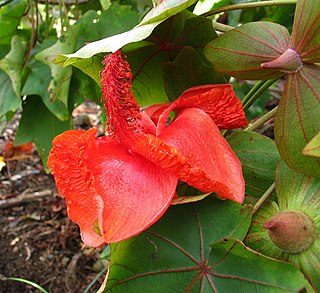
Kokia drynarioides, commonly known as Hawaiian tree cotton, is a species of flowering plant in the mallow family, Malvaceae, that is endemic to the Big Island of Hawaii. It inhabits dry forests at elevations of 455–1,915 m (1,493–6,283 ft). Associated plants include ʻāheahea, ʻaʻaliʻi, hala pepe, wiliwili, uhiuhi, kōlea, ʻaiea, kuluʻī, ʻālaʻa, ʻohe kukuluāeʻo, māmane, and maua. It is threatened by habitat loss and competition with invasive species, such as fountain grass.
Kokia kauaiensis, the Kauai treecotton or Kauaʻi Kokiʻo, is a species of flowering plant in the mallow family, Malvaceae, that is endemic to Kauaʻi, Hawaii.
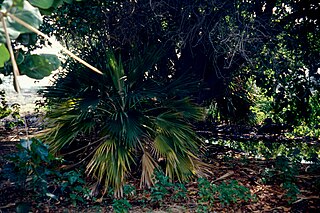
Pritchardia affinis, the Hawai'i pritchardia, is a species of palm tree that is endemic to the Hawaiian Islands. Wild populations currently exist on the leeward side of the Island of Hawaiʻi. It was most likely cultivated by Native Hawaiians, so its exact native range is uncertain. P. affinis reaches a height of 10–25 m (33–82 ft). It is threatened by rats and pigs, which damage the trees and eat the seeds before they can grow. It is a federally listed endangered species of the United States. Its fruit was reportedly the preferred food of the now-extinct ula-ai-hawane—a niche that has been seemingly filled by the introduced lavender waxbill.

Euphorbia haeleeleana, the Kauaʻi spurge, is a species of flowering plant in the croton family, Euphorbiaceae, that is endemic to the islands of Kauaʻi and Oaʻhu in Hawaii. Like other Hawaiian spurges it is known as `akoko.

Melicope knudsenii, commonly known as Olokele Valley melicope or Knudsen's melicope, is a species of flowering plant in the family Rutaceae, that is endemic to Hawaii. It inhabits montane mesic forests dominated by Acacia koa, Metrosideros polymorpha, and Dicranopteris linearis on Kauaʻi and East Maui (Auwahi). Associated plants include Syzygium sandwicensis, Cheirodendron trigynum, Myrsine lessertiana, Ilex anomala, Alphitonia ponderosa, Zanthoxylum dipetalum, Kadua terminalis, Pleomele aurea, Bobea spp., Tetraplasandra waimeae, Xylosma hawaiensis, Eurya sandwicensis, Psychotria mariniana, Melicope anisata, Melicope barbigera, Planchonella sandwicensis, Dodonaea viscosa, and Dianella sandwicensis. It is threatened by habitat loss. Like other Hawaiian Melicope, this species is known as alani. This is a federally listed endangered species of the United States.
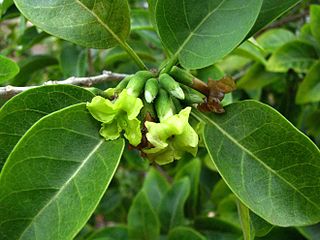
Nothocestrum breviflorum, commonly known as smallflower ʻaiea, is a species of tree in the nightshade family, Solanaceae, that is endemic to the island of Hawaiʻi. It inhabits dry and mixed mesic forests at elevations of 180–1,830 m (590–6,000 ft). These forests are dominated by ʻōhiʻa lehua and koa or lama, while plants associated with smallflower ʻaiea include wiliwili and uhiuhi. N. breviflorum reaches a height of 10–12 m (33–39 ft). It is threatened by habitat loss. It is federally listed as an endangered species of the United States. There are fewer than 50 individuals remaining.

Polyscias sandwicensis, known as the 'ohe makai or ʻOhe kukuluāeʻo in Hawaiian, is a species of flowering plant in the family Araliaceae, that is endemic to Hawaii. It is a tree, reaching a height of 4.6–15 m (15–49 ft) high with a trunk diameter of 0.5–0.6 m (1.6–2.0 ft). It can be found at elevations of 30–800 m (98–2,625 ft) on most main islands. Polyscias sandwicensis generally inhabits lowland dry forests, but is occasionally seen in coastal mesic and mixed mesic forests. It is threatened by habitat loss.
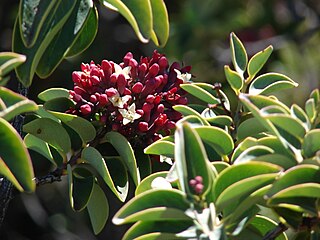
Santalum haleakalae, known as Haleakala sandalwood or ʻIliahi in Hawaiian, is a species of flowering tree in the sandalwood family, that is endemic to the islands of Maui, Lanai, and Molokai in the Hawaiian Islands, part of the United States. It grows in subalpine shrublands at elevations of 1,900 to 2,700 m, especially on the slopes of Haleakalā.

Sapindus oahuensis is a species of tree in the soapberry family, Sapindaceae. It is endemic to Hawaii, where it is limited to Kauaʻi and Oʻahu. Its common names include Āulu, Oahu soapberry, alulu, kaulu, and lonomea.

Urera kaalae, opuhe, is a species of flowering plant in the nettle family, Urticaceae, that is endemic to the island of Oʻahu in Hawaii. It inhabits slopes and gulches in mesic forests at elevations of 300–760 m (980–2,490 ft). Currently it is restricted to the southern and central parts of the Waiʻanae Mountains. Associated plants include maile, hame, Asplenium kaulfusii, Athyrium spp., ʻāwikiwiki, pāpala, ʻakoko, poʻolā, ēlama, Doryopteris spp., ʻieʻi.e., manono, Hibiscus spp., olopua, māmaki, hala pepe, ʻālaʻa, kōpiko, heuhiuhi, aʻiaʻi, ōpuhe, and maua. It is threatened by habitat loss.
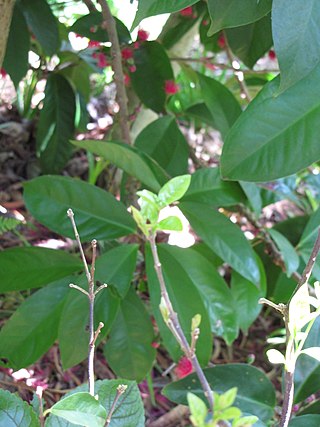
Wikstroemia bicornuta, the alpine false ohelo, is a species of flowering plant in the mezereon family, Thymelaeaceae, that is endemic to Hawaii. It inhabits mixed mesic and wet forests at elevations of 900–1,050 m (2,950–3,440 ft) on the islands of Lānaʻi and Maui. It is threatened by habitat loss.
Xylosma pachyphylla, commonly known as spiny logwood, is a species of flowering plant in the family Salicaceae, that is endemic to Puerto Rico. It can be found in forests on the island's western mountains, where it grows in serpentine soils. It is threatened by habitat loss.

Sideroxylon celastrinum is a species of flowering plant in the family Sapotaceae, that is native to Texas and Florida in the United States south through Central America to northern Venezuela and Colombia in South America. Common names include saffron plum and coma. It is a spiny shrub or small tree that reaches a height of 2–9 m (6.6–29.5 ft). The dark green leaves are alternate or fascicled at the nodes and oblanceolate to obovate. Greenish-white flowers are present from May to November and are followed by single-seeded, blue-black drupes.
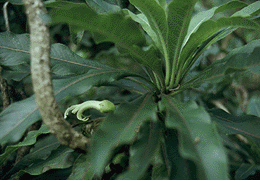
Clermontia pyrularia is a rare species of flowering plant in the bellflower family known by the common names Hamakua clermontia and pear clermontia. It is one of several Hawaiian lobelioids in genus Clermontia that are known as ʻoha wai and haha. It is endemic to the island of Hawaiʻi, where there is one remaining wild population containing 15 individuals and several propagated individuals that have been planted in protected habitat. This is a federally listed endangered species of the United States.
Cyanea glabra is a rare species of flowering plant in the family Campanulaceae known by the common name smooth cyanea. It is endemic to Maui, where there are twelve plants remaining in the wild. It was federally listed as an endangered species of the United States with nine other Maui Nui endemics in 1999. Like other Cyanea it is known as haha in Hawaiian.


















